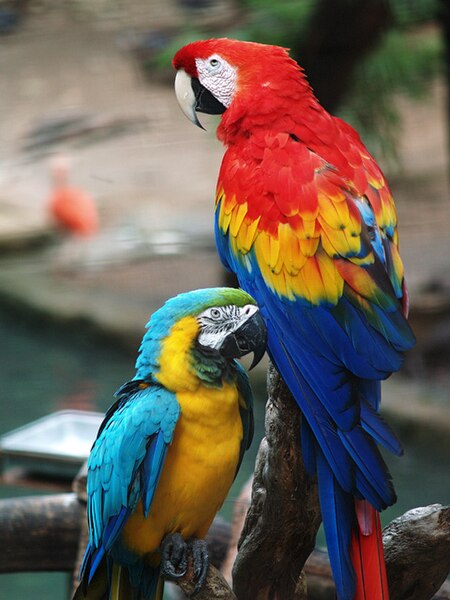 Many parrot enthusiasts view macaws as the ultimate avian pets. Huge, personable, gorgeous and enormously intelligent, macaws seem to embody all that is desirable in a pet parrot. However, macaw ownership is not to be undertaken lightly…while the rewards are great, there are many responsibilities and “downsides” to consider as well.
Many parrot enthusiasts view macaws as the ultimate avian pets. Huge, personable, gorgeous and enormously intelligent, macaws seem to embody all that is desirable in a pet parrot. However, macaw ownership is not to be undertaken lightly…while the rewards are great, there are many responsibilities and “downsides” to consider as well.
General Considerations
If you’ve ever been surprised by the volume of noise a budgie or lovebird can generate, consider what their massive relatives can do! Macaw vocalizations must be heard to be believed. I’ve observed Scarlet Macaws and others on Venezuela’s wide open grasslands, and have worked with them in huge zoo exhibits – even in these habitats, their calls were often deafening. Highly social, it is in their nature to vocalize almost continually.
Innate sociability drives macaws to bond with people, but many owners underestimate what this means. An hour or 2 spent with your bird before and after work is rarely enough to meet its needs. Wild macaws are never out of contact with mates and flock members for long…pets, especially those housed alone, demand more attention than most owners can provide. And even with a great deal of close contact, the relationship can be rocky. While macaws can be among the sweetest of all pets, most have very strong personalities and will test you on a regular basis. Large, powerful beaks and brains render them as birds to be taken seriously.
All parrots, even the tiniest, need lots of space. This fact of parrot life takes on greater importance when your pet is a 30-40 inch long, highly active macaw. Close confinement is torturous for macaws, and will lead to a host of often irreversible problems.
The aforementioned points apply to all macaws. Following is some information that is specific to individual species. Please bear in mind that while a species may exhibit certain tendencies, individual personalities will vary, and a bird’s past history will greatly affect its potential as a pet. As with all animals, certain individuals will appear to break all of their “species’ rules”.
Big and Beautiful, but…
The spectacularly beautiful Scarlet Macaw is among the world’s most recognizable birds. However, as regards pet potential, its beauty is often “skin deep”. Scarlet Macaws are strong-willed and quick to take offense. This, coupled with their natural tendency to communicate physically, i.e. by nips and bites, renders them as birds best left to well-experienced keepers.
Other species sharing the Scarlet’s characteristics are the Military, Severe and Buffon’s Macaws.
Ideal Large Macaw
The Green-Winged (Red and Green) Macaw is an excellent “alternative” to the Scarlet. Among the largest of its family, the Green Wing looks a lot like the Scarlet Macaw, but is, in general, a much calmer bird. Most individuals have very steady personalities, and many develop impressive vocabularies.
The Blue and Gold Macaw has been a favorite of mine ever since I cared for a group of youngsters at a bird importer’s facility many years ago. My boisterous little gang acted like a bunch of puppies, even rolling on their backs and “pawing” the air. In time, I learned that many keepers considered Blue and Golds to be among the most intelligent and playful of all macaws. They are loud, but almost always mild-mannered, and very “forgiving” of typical first-timer mistakes.
The Blue-Throated Macaw puts one in mind of a scaled down Blue and Gold, and is also a good choice for those new to macaw keeping.
The huge Hyacinth Macaw, largest of all, often makes a fine pet and mimics words quite well. At once imposing and beautiful, Hyacinths demand a great deal of attention but are usually very gentle to those with whom they bond.
Mini Macaws…a Wonderful “Compromise”

The Yellow-Collared Macaw is small by macaw standards, but requires a calm, knowledgeable owner who can control its free-wheeling temperament.
Further Reading
Observations on Wild Scarlet Macaws
Hyacinth Macaw Conservation
Macaw Overview: further thoughts on various species
Scarlet and Blue and Gold Macaw image referenced from wikipedia and originally posted by eddy
Red and Green Macaw image referenced from wikipedia and originally posted by Lee
Hahn’s Macaw image referenced from wikipedia and originally posted by Snowmanradio
 That Bird Blog – Bird Care and History for Pet Birds
That Bird Blog – Bird Care and History for Pet Birds




Macaws are not for everyone. They live up 80 years old and take a lot of attention and upkeep not to mention the cost of owning them. We have been around macaws for many years and know the habits of the largest (hyacinth) to the smallest (hahns) macaws. Macaws have great personalities and most like to be around people they trust. If you are inclined to adopt a macaw into your life do so with the intent of keeping it for many years.
Hello
Thanks for your interesting and informative comment.
Best regards, Frank Indiviglio.